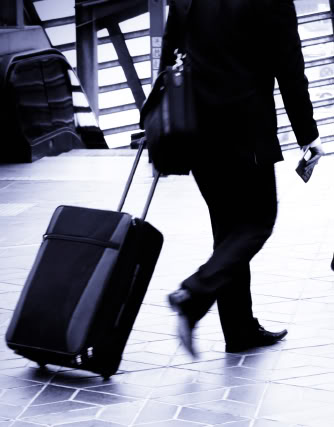Taking a Vacation WITH Technology
February 13, 2013
 If you Google just about any phrase involving "vacation" and "technology" you end up with search results much like the following:
If you Google just about any phrase involving "vacation" and "technology" you end up with search results much like the following:
- "How to escape from technology while on vacation"
- "Take a vacation from technology"
- "Technology-free vacation"
That's rubbish. I don't want to escape from technology when I go on vacation. I rarely have fewer than two digital devices on my person at any given time, and I want to take it all with me. I want my personal technology to help me to have a better vacation, enabling me to spend my down time while still staying connected to my job, my family, my friends and my digital life.
So if you're planning a vacation and want to make the most out of your personal technology along the way, here are just a few tips for you to consider.
Check the Wi-Fi
This was a big one for us during last year's trip to Europe. We had been assured that both of the hotels we planned to stay at in Italy had free wi-fi for their guests. Well, the hotel in Rome turned out to be a monastery (I kid you not) with slower-than-dialup wi-fi only available in the lobby. The hotel in Catania advertised free wireless Internet on their website, but when we got there we were told that it had been broken for weeks and wouldn't be fixed any time soon. The only real option was an Internet cafe, but every time we were away from the hotel were going a mile a minute and didn't really have the option to sit and surf.
The high point of the trip—for many of the high schoolers in our tour group—was when we visited Sigonella Naval Air Station, a US air base on the southern coast of Sicily. Word spread almost instantly that there was a strong wi-fi network, freely available, and everyone settled down for a refreshing hour of e-mail, Facebook, and Skype. My wife and I were finally able to put a FaceTime call through to our children back in the United States.
Again, it's impossible to underestimate the importance of having a place to get bandwidth.
Cables, Adapters and Storage
Bring every cable you could possibly need, and then some. Better yet, invest in one of those all-in-one cables, which has adapters for all of the varieties of USB. You probably won't complain that you carried a particular cable with you to Cabo and back, but you certainly will be disgusted with yourself if you get there and find you're missing the one with the special connector that lets you offload the pictures from your camera.
In addition, estimate the number of pictures you expect to take, quadruple that, and then take inventory of how much mobile storage you're bringing along. Start every trip with empty memory cards, so you don't find yourself deleting older photos to make room for new ones. Give yourself a way to get photos out of your camera so you can take more—or better yet, just bring along multiple cards. Digital storage is cheap, so there's really no excuse for ever running out of memory for your memories.
Oh, and one more thing. If you're traveling with children or teenagers, bring more than one audio splitter, so they can listen to each others' devices. You won't regret it.
Bring Plenty of Juice
I honestly believe that people who design hotel rooms intentionally limit the number of open outlets just to annoy me. Some hotels are catching on, but lots of them still give you a single outlet in the bathroom to plug in your charger. Because of this, I always travel with a power strip. It takes up very little space in my bag, but allows me to plug in my phone, my camera, my table, my e-reader and my laptop all at once. If you're traveling abroad, make sure you have a power adapter that will work with everything you expect to plug in.
If you really want to be popular, be sure to pack your power strip in your carry-on luggage. That way, when you're charging in the airport, others can plug in as well. You might make a new friend or two, and at the very least you won't get nasty looks from fellow travellers because you're bogarting the one available power outlet.
One more caution about charging is in order here. If you are using an external charger to juice up a device that uses removable batteries, leave the battery doors open while you're charging. That way, the next morning, you will hopefully notice the open door and remember to put your battery back in the device. Last year in Rome, my wife forgot to replace the battery in her camera before leaving the hotel on a guided tour of the Colosseum and the Roman Forum. I let her use my camera because she's a better picture taker than I am, but she really missed the features of her camera, which is better than mine. Bummer!
Communicate Differently
You and your cell phone may be joined at the hip when you're in "normal" mode, but when you're in another country it's sometimes better to find alternative ways of communicating. Obviously, e-mail and instant messaging are great options. If you must talk live to another person, Skype is great, and works on just about every device imaginable. If you're just communicating via Apple OS devices, FaceTime gives you video and audio with little fuss or setup.
Another great free tool is Google Voice. You can forward your regular mobile number to your Google Voice number, and people can leave messages that you can access cheaply from just about anywhere you can get an Internet connection.
Keep Tabs on Your Tech
It goes without saying that you shouldn't ever leave your tech gadgets sitting in a public place where someone could do a quick grab and run. But there are plenty of other ways you could lose your stuff. Depending on where you're staying, leaving them unprotected in your hotel room is often a very bad choice. If your hotel offers in-room safes, that's where your devices should live if you don't take them along.
Also, it's not a great idea to put expensive technology in checked baggage, where it can get damaged or stolen. Put it in your carry-on, and then watch your bags as they are inspected by airport security and customs officers. It'd be nice to think you could trust the friendly person with the blue rubber gloves who paws through your stuff. Whether or not you hold this rosy view of the world, there are plenty of recent stories of missing phones, iPads and other devices—which were ultimately tied to sticky-fingered TSA agents—that might make you rethink your position.
These are just a few of tech-travel "best practices" that I could come up with. Does anyone have some other important ones they'd like to share?
